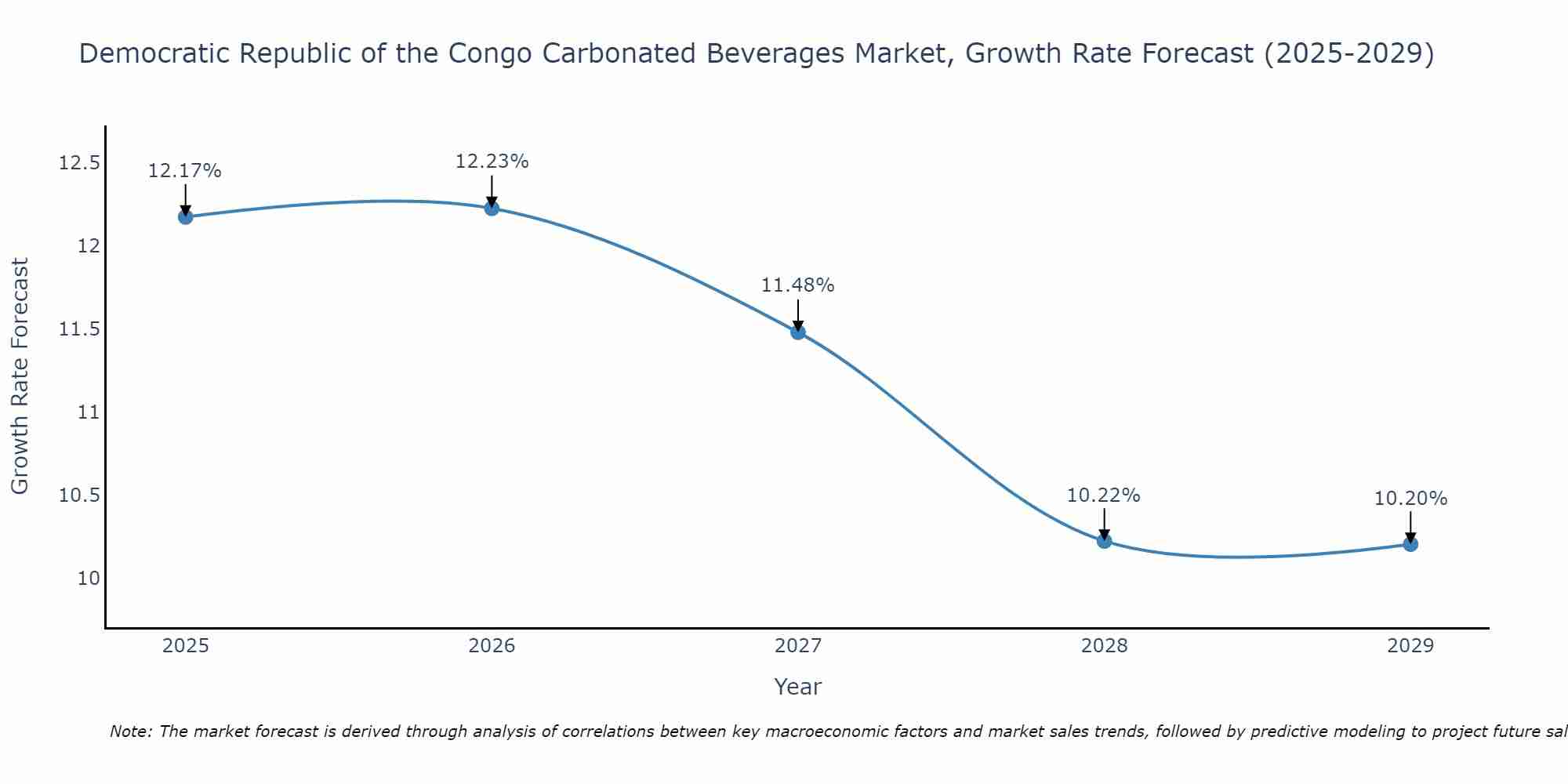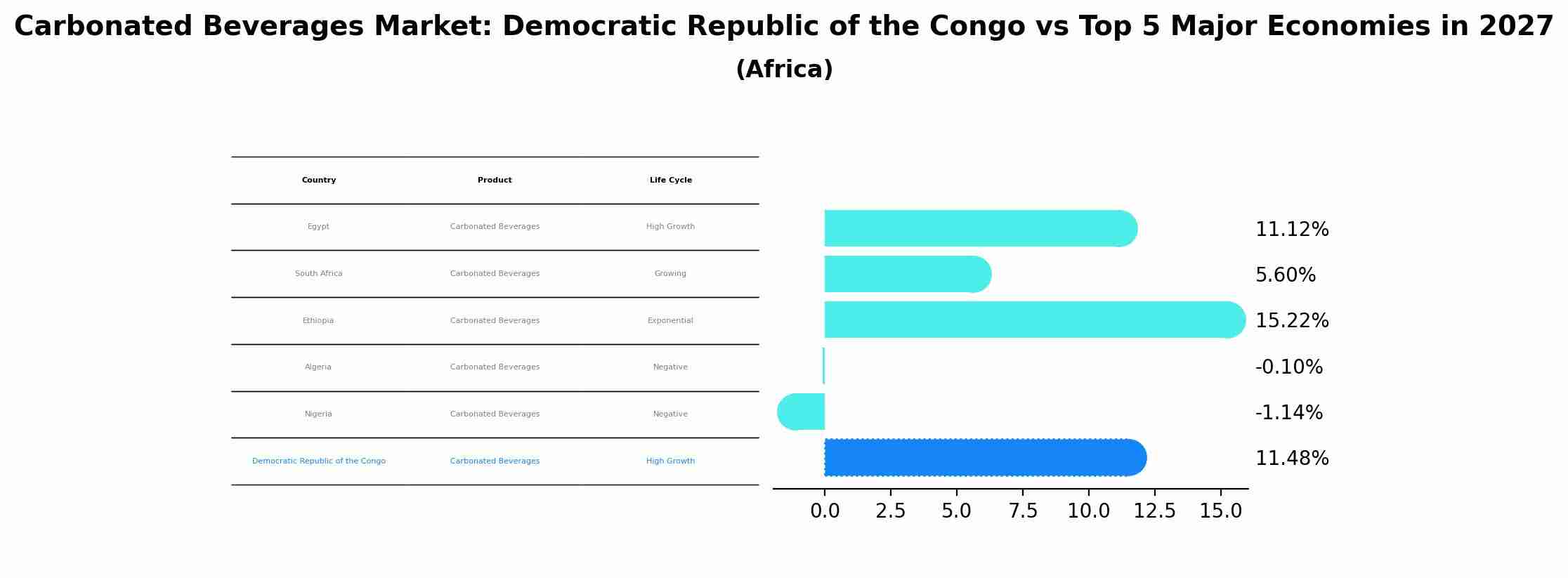Congo Carbonated Beverages Market (2025-2031) | Share, Value, Companies, Analysis, Growth, Trends, Size, Revenue, Outlook, Forecast, Industry & Segmentation
| Product Code: ETC5375480 | Publication Date: Nov 2023 | Updated Date: Oct 2025 | Product Type: Market Research Report | |
| Publisher: 6Wresearch | Author: Bhawna Singh | No. of Pages: 60 | No. of Figures: 30 | No. of Tables: 5 |
Democratic Republic of the Congo Carbonated Beverages Market Size Growth Rate
The Democratic Republic of the Congo Carbonated Beverages Market is projected to witness mixed growth rate patterns during 2025 to 2029. Starting at 12.17% in 2025, the market peaks at 12.23% in 2026, and settles at 10.20% by 2029.

Carbonated Beverages Market: Democratic Republic of the Congo vs Top 5 Major Economies in 2027 (Africa)
In the Africa region, the Carbonated Beverages market in Democratic Republic of the Congo is projected to expand at a high growth rate of 11.48% by 2027. The largest economy is Egypt, followed by South Africa, Ethiopia, Algeria and Nigeria.

Congo Carbonated Beverages Market Overview
The carbonated beverages market in Congo is experiencing growth due to rising consumer preferences for fizzy drinks and an expanding middle class with increasing disposable income. Local and international beverage companies are investing in the market to cater to the growing demand. However, challenges such as fluctuating raw material costs, supply chain disruptions, and health concerns related to sugar consumption impact market dynamics. Additionally, competition from non-carbonated beverage alternatives and regulatory pressures on sugar content pose challenges. Nevertheless, the market`s growth potential is bolstered by increasing urbanization and evolving consumer tastes.
Drivers of the market
The Congo Carbonated Beverages Market is propelled by the growing popularity of carbonated drinks among consumers, driven by factors such as taste preferences and the availability of diverse product options. Increasing disposable incomes and urbanization contribute to higher consumption rates. The expansion of retail and distribution channels enhances market accessibility, further fueling demand. Innovations in product offerings, including reduced sugar and enhanced flavors, also play a role in driving market growth.
Challenges of the market
In Congo, the carbonated beverages market faces challenges such as limited distribution networks and infrastructure issues. There are also barriers related to high production and import costs, as well as competition from local and informal beverage producers. Economic instability and fluctuations in consumer purchasing power further impact market growth.
Government Policy of the market
The Congo Carbonated Beverages Market is influenced by government policies on public health, taxation, and trade. Policies aimed at controlling sugar consumption and promoting healthier alternatives could impact demand for carbonated beverages. Regulations on labeling, advertising, and distribution also play a role in shaping the market. Furthermore, trade policies affecting the import and export of carbonated beverages can impact market dynamics.
Key Highlights of the Report:
- Congo Carbonated Beverages Market Outlook
- Market Size of Congo Carbonated Beverages Market, 2024
- Forecast of Congo Carbonated Beverages Market, 2031
- Historical Data and Forecast of Congo Carbonated Beverages Revenues & Volume for the Period 2021-2031
- Congo Carbonated Beverages Market Trend Evolution
- Congo Carbonated Beverages Market Drivers and Challenges
- Congo Carbonated Beverages Price Trends
- Congo Carbonated Beverages Porter`s Five Forces
- Congo Carbonated Beverages Industry Life Cycle
- Historical Data and Forecast of Congo Carbonated Beverages Market Revenues & Volume By Product Types for the Period 2021-2031
- Historical Data and Forecast of Congo Carbonated Beverages Market Revenues & Volume By Soft Drinks for the Period 2021-2031
- Historical Data and Forecast of Congo Carbonated Beverages Market Revenues & Volume By Carbonated Water for the Period 2021-2031
- Historical Data and Forecast of Congo Carbonated Beverages Market Revenues & Volume By Sports & Energy Drinks for the Period 2021-2031
- Historical Data and Forecast of Congo Carbonated Beverages Market Revenues & Volume By Others for the Period 2021-2031
- Historical Data and Forecast of Congo Carbonated Beverages Market Revenues & Volume By Flavour for the Period 2021-2031
- Historical Data and Forecast of Congo Carbonated Beverages Market Revenues & Volume By Cola for the Period 2021-2031
- Historical Data and Forecast of Congo Carbonated Beverages Market Revenues & Volume By Fruit Based for the Period 2021-2031
- Historical Data and Forecast of Congo Carbonated Beverages Market Revenues & Volume By Others for the Period 2021-2031
- Historical Data and Forecast of Congo Carbonated Beverages Market Revenues & Volume By Distribution Channel for the Period 2021-2031
- Historical Data and Forecast of Congo Carbonated Beverages Market Revenues & Volume By Hypermarkets & Supermarkets for the Period 2021-2031
- Historical Data and Forecast of Congo Carbonated Beverages Market Revenues & Volume By Convenience Stores for the Period 2021-2031
- Historical Data and Forecast of Congo Carbonated Beverages Market Revenues & Volume By Food Service Outlets for the Period 2021-2031
- Historical Data and Forecast of Congo Carbonated Beverages Market Revenues & Volume By Transport Terminals for the Period 2021-2031
- Historical Data and Forecast of Congo Carbonated Beverages Market Revenues & Volume By Online Stores & D2C for the Period 2021-2031
- Congo Carbonated Beverages Import Export Trade Statistics
- Market Opportunity Assessment By Product Types
- Market Opportunity Assessment By Flavour
- Market Opportunity Assessment By Distribution Channel
- Congo Carbonated Beverages Top Companies Market Share
- Congo Carbonated Beverages Competitive Benchmarking By Technical and Operational Parameters
- Congo Carbonated Beverages Company Profiles
- Congo Carbonated Beverages Key Strategic Recommendations
Frequently Asked Questions About the Market Study (FAQs):
1 Executive Summary |
2 Introduction |
2.1 Key Highlights of the Report |
2.2 Report Description |
2.3 Market Scope & Segmentation |
2.4 Research Methodology |
2.5 Assumptions |
3 Congo Carbonated Beverages Market Overview |
3.1 Congo Country Macro Economic Indicators |
3.2 Congo Carbonated Beverages Market Revenues & Volume, 2021 & 2031F |
3.3 Congo Carbonated Beverages Market - Industry Life Cycle |
3.4 Congo Carbonated Beverages Market - Porter's Five Forces |
3.5 Congo Carbonated Beverages Market Revenues & Volume Share, By Product Types, 2021 & 2031F |
3.6 Congo Carbonated Beverages Market Revenues & Volume Share, By Flavour, 2021 & 2031F |
3.7 Congo Carbonated Beverages Market Revenues & Volume Share, By Distribution Channel, 2021 & 2031F |
4 Congo Carbonated Beverages Market Dynamics |
4.1 Impact Analysis |
4.2 Market Drivers |
4.2.1 Increasing disposable income in Congo |
4.2.2 Changing consumer preferences towards convenience and ready-to-drink beverages |
4.2.3 Growing urbanization leading to higher demand for on-the-go beverages |
4.3 Market Restraints |
4.3.1 Health concerns related to high sugar content in carbonated beverages |
4.3.2 Competition from alternative beverage options like bottled water and fruit juices |
4.3.3 Fluctuating prices of key ingredients impacting production costs |
5 Congo Carbonated Beverages Market Trends |
6 Congo Carbonated Beverages Market Segmentations |
6.1 Congo Carbonated Beverages Market, By Product Types |
6.1.1 Overview and Analysis |
6.1.2 Congo Carbonated Beverages Market Revenues & Volume, By Soft Drinks, 2021-2031F |
6.1.3 Congo Carbonated Beverages Market Revenues & Volume, By Carbonated Water, 2021-2031F |
6.1.4 Congo Carbonated Beverages Market Revenues & Volume, By Sports & Energy Drinks, 2021-2031F |
6.1.5 Congo Carbonated Beverages Market Revenues & Volume, By Others, 2021-2031F |
6.2 Congo Carbonated Beverages Market, By Flavour |
6.2.1 Overview and Analysis |
6.2.2 Congo Carbonated Beverages Market Revenues & Volume, By Cola, 2021-2031F |
6.2.3 Congo Carbonated Beverages Market Revenues & Volume, By Fruit Based, 2021-2031F |
6.2.4 Congo Carbonated Beverages Market Revenues & Volume, By Others, 2021-2031F |
6.3 Congo Carbonated Beverages Market, By Distribution Channel |
6.3.1 Overview and Analysis |
6.3.2 Congo Carbonated Beverages Market Revenues & Volume, By Hypermarkets & Supermarkets, 2021-2031F |
6.3.3 Congo Carbonated Beverages Market Revenues & Volume, By Convenience Stores, 2021-2031F |
6.3.4 Congo Carbonated Beverages Market Revenues & Volume, By Food Service Outlets, 2021-2031F |
6.3.5 Congo Carbonated Beverages Market Revenues & Volume, By Transport Terminals, 2021-2031F |
6.3.6 Congo Carbonated Beverages Market Revenues & Volume, By Online Stores & D2C, 2021-2031F |
7 Congo Carbonated Beverages Market Import-Export Trade Statistics |
7.1 Congo Carbonated Beverages Market Export to Major Countries |
7.2 Congo Carbonated Beverages Market Imports from Major Countries |
8 Congo Carbonated Beverages Market Key Performance Indicators |
8.1 Percentage growth in distribution network coverage |
8.2 Consumer engagement levels on social media platforms |
8.3 Rate of new product innovations in response to market trends |
9 Congo Carbonated Beverages Market - Opportunity Assessment |
9.1 Congo Carbonated Beverages Market Opportunity Assessment, By Product Types, 2021 & 2031F |
9.2 Congo Carbonated Beverages Market Opportunity Assessment, By Flavour, 2021 & 2031F |
9.3 Congo Carbonated Beverages Market Opportunity Assessment, By Distribution Channel, 2021 & 2031F |
10 Congo Carbonated Beverages Market - Competitive Landscape |
10.1 Congo Carbonated Beverages Market Revenue Share, By Companies, 2024 |
10.2 Congo Carbonated Beverages Market Competitive Benchmarking, By Operating and Technical Parameters |
11 Company Profiles |
12 Recommendations | 13 Disclaimer |
- Single User License$ 1,995
- Department License$ 2,400
- Site License$ 3,120
- Global License$ 3,795
Search
Thought Leadership and Analyst Meet
Our Clients
Related Reports
- Germany Breakfast Food Market (2026-2032) | Industry, Share, Growth, Size, Companies, Value, Analysis, Revenue, Trends, Forecast & Outlook
- Australia Briquette Market (2025-2031) | Growth, Size, Revenue, Forecast, Analysis, Trends, Value, Share, Industry & Companies
- Vietnam System Integrator Market (2025-2031) | Size, Companies, Analysis, Industry, Value, Forecast, Growth, Trends, Revenue & Share
- ASEAN and Thailand Brain Health Supplements Market (2025-2031) | Strategy, Consumer Insights, Analysis, Investment Trends, Opportunities, Growth, Size, Share, Industry, Revenue, Segments, Value, Segmentation, Supply, Forecast, Restraints, Outlook, Competition, Drivers, Trends, Demand, Pricing Analysis, Competitive, Strategic Insights, Companies, Challenges
- ASEAN Bearings Market (2025-2031) | Strategy, Consumer Insights, Analysis, Investment Trends, Opportunities, Growth, Size, Share, Industry, Revenue, Segments, Value, Segmentation, Supply, Forecast, Restraints, Outlook, Competition, Drivers, Trends, Demand, Pricing Analysis, Competitive, Strategic Insights, Companies, Challenges
- Europe Flooring Market (2025-2031) | Outlook, Share, Industry, Trends, Forecast, Companies, Revenue, Size, Analysis, Growth & Value
- Saudi Arabia Manlift Market (2025-2031) | Outlook, Size, Growth, Trends, Companies, Industry, Revenue, Value, Share, Forecast & Analysis
- Uganda Excavator, Crane, and Wheel Loaders Market (2025-2031) | Strategy, Consumer Insights, Analysis, Investment Trends, Opportunities, Growth, Size, Share, Industry, Revenue, Segments, Value, Segmentation, Supply, Forecast, Restraints, Outlook, Competition, Drivers, Trends, Demand, Pricing Analysis, Competitive, Strategic Insights, Companies, Challenges
- Rwanda Excavator, Crane, and Wheel Loaders Market (2025-2031) | Strategy, Consumer Insights, Analysis, Investment Trends, Opportunities, Growth, Size, Share, Industry, Revenue, Segments, Value, Segmentation, Supply, Forecast, Restraints, Outlook, Competition, Drivers, Trends, Demand, Pricing Analysis, Competitive, Strategic Insights, Companies, Challenges
- Kenya Excavator, Crane, and Wheel Loaders Market (2025-2031) | Strategy, Consumer Insights, Analysis, Investment Trends, Opportunities, Growth, Size, Share, Industry, Revenue, Segments, Value, Segmentation, Supply, Forecast, Restraints, Outlook, Competition, Drivers, Trends, Demand, Pricing Analysis, Competitive, Strategic Insights, Companies, Challenges
Industry Events and Analyst Meet
Whitepaper
- Middle East & Africa Commercial Security Market Click here to view more.
- Middle East & Africa Fire Safety Systems & Equipment Market Click here to view more.
- GCC Drone Market Click here to view more.
- Middle East Lighting Fixture Market Click here to view more.
- GCC Physical & Perimeter Security Market Click here to view more.
6WResearch In News
- Doha a strategic location for EV manufacturing hub: IPA Qatar
- Demand for luxury TVs surging in the GCC, says Samsung
- Empowering Growth: The Thriving Journey of Bangladesh’s Cable Industry
- Demand for luxury TVs surging in the GCC, says Samsung
- Video call with a traditional healer? Once unthinkable, it’s now common in South Africa
- Intelligent Buildings To Smooth GCC’s Path To Net Zero


















